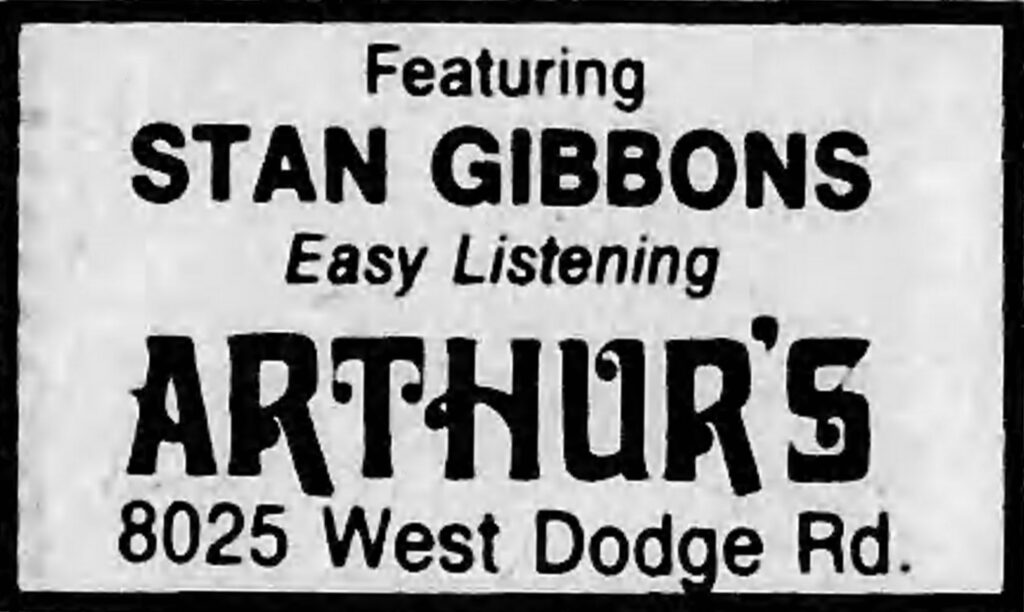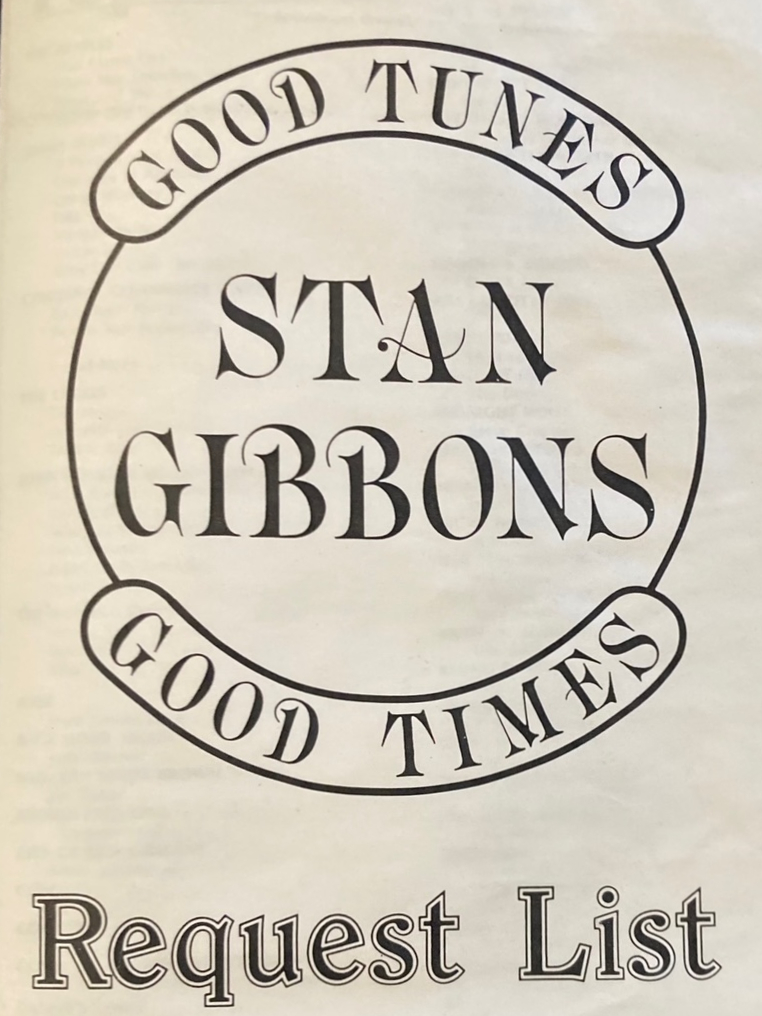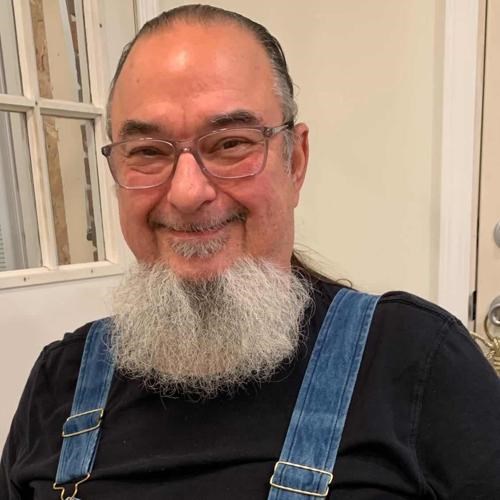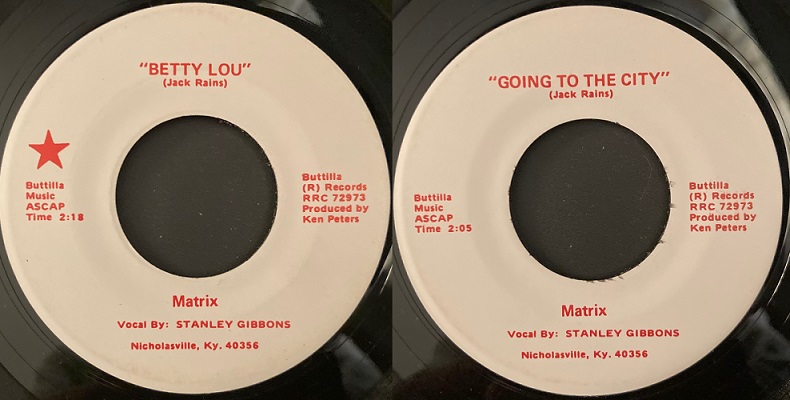This tribute to Matrix is marked by sadness over the death of Stan Gibbons. I had started this late last summer and finally had the chance to interview Stan at his home in Paris just back in December. We were still working on details and exchanging messages when I heard of his sudden passing. I dedicate this to his lovely wife Shelia as well as the rest of his family and countless friends who were touched by his big personality and musical talent. [2024 Shawn Chambers / Lexingtunes]
Stan Gibbons felt lost in Lexington. To a small-town boy raised in nearby Versailles, Kentucky, the general clatter of the massive student body at Henry Clay High School made the cozy confines of his old school in Woodford County feel a world away. Navigating cliques is a challenge for any new student and making friends was tough, so when he received an invitation to go and spin some records from a fellow “long hair” he eagerly accepted.
Bassist Frank Marz bonded with Gibbons over music and quickly invited him to a practice session for his band Trash. The new band was rehearsing at manager Ken Peters’ house and Gibbons as a keen music fan and guitar player himself was thrilled to check it out. Perhaps even more thrilling to Stan was walking into the band space and seeing his old Woodford County pal John Kirchhubel on lead guitar. The feel-good moment quickly faded. Gibbons recalls:
So the lead singer shows up with his girlfriend and is really acting like a fool. Peters was older than us by maybe ten years or so and he was getting red. Finally someone turned to me and said ‘Hey, can you sing?’ (laughs) So then I was in the band with Johnny and Frank.
It is not certain when Matrix took out the Trash, but by the band’s first prime gig in July of 1973 the new name was firmly in place. The boys had a successful appearance at the Blue Grass Fair alongside other amateurs prior to the headlining act of Tony Orlando and Dawn.
Ken Peters did his job and managed to get a plug in the local paper for the band’s performance of “Betty Lou” as well as a bit of hyperbole when he suggested this song was one “which they expect to record for Columbia Records in the near future.”
Well, the next day we saw that in the Herald-Leader and just laughed and laughed. No one had ever mentioned us even talking to Columbia much less recording for them. This was pure Ken hype! – Stan Gibbons
The REAL recording session did take place very soon after, but locally at Lemco Studios. It was an arrangement between Ken Peters and Jack Rains (owner of Buttilla Records amongst others). Rains had the budget locked in and the boys were only allotted time to record two tracks, which would subsequently appear on his own label. It was a brisk session with an unknown local girl brought in to play piano and just a single overdub for some extra guitar on the B-side.
The A-side “Betty Lou” has a bluesy-country feel at the start and leaves Gibbons the task of delivering vocals to Rains’ odd rhyming scheme. Rains would go even further and it was he who suggested the vocal inflections that Gibbons tongue-twisted around.
I really did not like singing that they way he wanted…but he was paying. That time at the fair and the studio was the only time I remember us doing that tune. I guess I did feel a little bit guilty though when I saw my name credited on the label. – Stan Gibbons
Despite this being the plug-side and getting at least some airplay on at least one station in eastern Kentucky it did not break through like Jack had hoped. Timing…luck…who knows? Maybe Rains was an early genius. Heck, a decade later and “Swingin’” soared to number one riding a similar theme and some slightly exaggerated country vocals by John Anderson.
The B-side is far more representative of the country-rock style of Matrix. Frank delivers a catchy bassline swiftly followed by some great harmonica from Gibbons. “Going To The City” was again penned by Rains, but without his vocal micromanaging the ‘country boy goes to town’ tale is delivered nicely by Gibbons.
Because Matrix was a band of hired guns for the session, they had little chance to promote the record themselves. Jack gave each member just a few copies and kept the rest for promo mailings and dropping around local stations. It is likely at least a few were consigned through Esco Hankins’ Record Shop as at least one copy traces to that source.
With product in hand Jack Rains faded again into the band’s background, but the boys were still hungry to perform. Finding an audience beyond the local fairground was a daunting task for the group of freshly minted high school grads, however. Not only were the Matrix members too young to play the legitimate bars in town, but also the popular clubs were notorious for locking in local acts for months or even years at time. Teen clubs? Not really. The heyday of the great ‘60s teen spots like the Carnaby Club were well in the rearview mirror. While not exactly turning to the dark side, Matrix certainly wandered into the grey areas of towns.
Operating just within the law (or at least with a nod-and-a-wink to it) were Lexington’s “after hours” clubs. With entertainment starting at midnight or later and stretching until biscuits and gravy were on the plate, clubs such as Rocky Top on Lane Allen Road or 803 South on Broadway were themselves trying to find an audience and booking top entertainment was key.
The self-proclaimed “House of the Unusual” venue 803 South operated as a supper club that kept going until 4 a.m. The Gene Nelson Trio and jazz great Winston Walls were already contracted, but even regulars need a night off. Stan recalls:
So we auditioned at the club there… Winston Walls was there at the time with his big Hammond B3…and here we were! We played a couple songs and all I remember was Winston walking by and saying ‘Ya’ll sure got your own style.’ I never did find out it that was good or bad (laughs), but I don’t remember us ever getting called back!
Matrix had better luck at Rocky Top. What was supposed to be a joint serving up late-night entertainment along with some food and drink mixers for the ‘bring your own’ crowd ended up being busted multiple times for illegal liquor sales. Still the few Matrix appearances there were remembered by Gibbons as well-received but “heck, at three in the morning a bunch of drunks will listen to anything.”
The end of Matrix spread out over a few months in late 1973. One day guitarist Kirchhubel just stopped showing up at practice and dropped out of contact. Stan shifted to full-time guitar duties, but also changed the sound by introducing his 12 string into the band. It was all for naught in the end. Frank Marz accepted a gig with a touring band and the loss of their skilled bassist was enough to make the others call it a day.
Stan Gibbons drifted into the Air Force in 1975 and was stationed in Omaha, Nebraska, where he promptly won a talent contest on the base and began working the local open-mic circuit in town. His time in the Midwest ended with his military stint in 1979 and he returned to the Bluegrass and to the second phase of his music career.

Backed by his GI Bill, he completed his journalism degree at the University of Kentucky and his nightly extra-curricular activities were of the behind-the-mic variety. The campus neighborhood was alive with music and Stan was in the thick of it all. A regular at Doozies (later Cats Eatery and Pub), he also brought his talents to the legendary Chevy Chase Inn, Bill Spivey’s, Panchos, B.C.’s Restaurant and Lounge, The Thoroughbred Restaurant, and The Bearded Seale. Day trips might include the Settler’s Cabin on the banks of the Kentucky River or a trip to western KY for a Boiler Room gig in Owensboro.

Known for his harmonica, Gibbons literally had an extensive ‘menu’ of prime cuts from the likes of Bob Dylan naturally, but also John Prine, Pete Seeger and other singer/songwriters as well as Top 40 hits. His “Good Tunes – Good Times” slogan would appear on his printed request list and even made its way to some custom t-shirts for fans.
 Lexington music fans would lose Gibbons for a few years to nearby West Virginia where he continued with Ersal (sic) Hickey & The Squirrels From Hell in the very late ’80s or early ’90s, but he would return and take up right where he left off with gigs spanning into the new century at Franks’ Place, Duggans and countless private events.
Lexington music fans would lose Gibbons for a few years to nearby West Virginia where he continued with Ersal (sic) Hickey & The Squirrels From Hell in the very late ’80s or early ’90s, but he would return and take up right where he left off with gigs spanning into the new century at Franks’ Place, Duggans and countless private events.
In recent years, Stan settled down to married life in nearby Paris and contributed his harmonica and guitar to the musical offerings during services at the Seventh Street Christian Church. Joel Stanley Gibbons passed away unexpectedly on January 1, 2024.
As for the rest of Matrix? It is like gathering leaves in the wind. Frank Marz was last known to be in the Pacific Northwest area as late as 2006, but despite repeated attempts was unable to be contacted.
John Kirchhubel relocated to Louisville as early as 1975 based on some minor traffic infractions tracked in the local papers. His name resurfaced in a most unfortunate way in 1994, when Kirchhubel was accused of abusing a child. Despite an early investigation providing no proof of this, he was nevertheless confronted at his home by the boyfriend of the girl’s mother. Clearly an argument ensued and Kirchhubel was stabbed dozens of times and left to die. His killer was sentenced to 25 years in prison.
There were at least two different drummers in the band, but the names are still in the ether. Perhaps someday better details will emerge about the band’s formation, but for now… this was MATRIX!
Discography:
72973 Buttilla Betty Lou / Going To The City 1973

NOTE – Jack Rains was a long time employee of the Kentucky Water Company and generally used his home address as his label’s address. At this point in time, Rains was working in Nicholasville, KY.